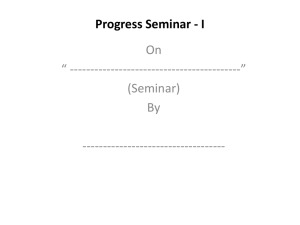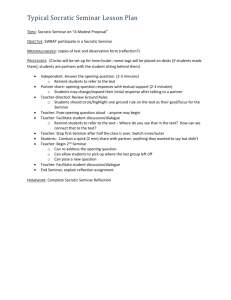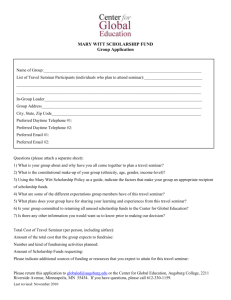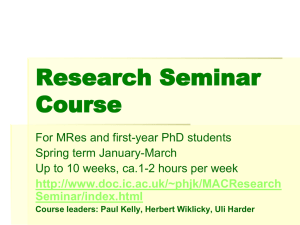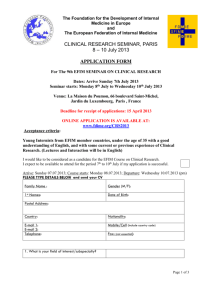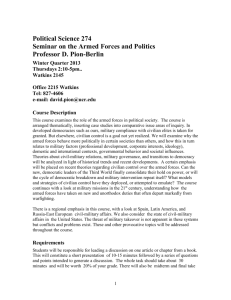Creating and organizing military power (Word)
advertisement
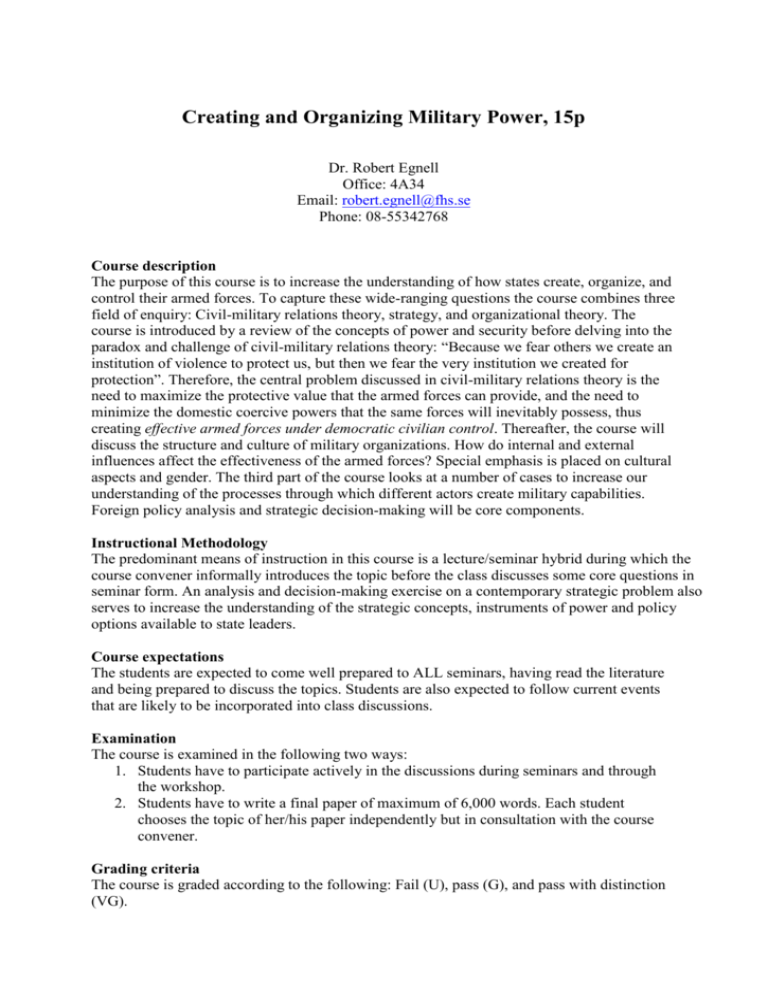
Creating and Organizing Military Power, 15p Dr. Robert Egnell Office: 4A34 Email: robert.egnell@fhs.se Phone: 08-55342768 Course description The purpose of this course is to increase the understanding of how states create, organize, and control their armed forces. To capture these wide-ranging questions the course combines three field of enquiry: Civil-military relations theory, strategy, and organizational theory. The course is introduced by a review of the concepts of power and security before delving into the paradox and challenge of civil-military relations theory: “Because we fear others we create an institution of violence to protect us, but then we fear the very institution we created for protection”. Therefore, the central problem discussed in civil-military relations theory is the need to maximize the protective value that the armed forces can provide, and the need to minimize the domestic coercive powers that the same forces will inevitably possess, thus creating effective armed forces under democratic civilian control. Thereafter, the course will discuss the structure and culture of military organizations. How do internal and external influences affect the effectiveness of the armed forces? Special emphasis is placed on cultural aspects and gender. The third part of the course looks at a number of cases to increase our understanding of the processes through which different actors create military capabilities. Foreign policy analysis and strategic decision-making will be core components. Instructional Methodology The predominant means of instruction in this course is a lecture/seminar hybrid during which the course convener informally introduces the topic before the class discusses some core questions in seminar form. An analysis and decision-making exercise on a contemporary strategic problem also serves to increase the understanding of the strategic concepts, instruments of power and policy options available to state leaders. Course expectations The students are expected to come well prepared to ALL seminars, having read the literature and being prepared to discuss the topics. Students are also expected to follow current events that are likely to be incorporated into class discussions. Examination The course is examined in the following two ways: 1. Students have to participate actively in the discussions during seminars and through the workshop. 2. Students have to write a final paper of maximum of 6,000 words. Each student chooses the topic of her/his paper independently but in consultation with the course convener. Grading criteria The course is graded according to the following: Fail (U), pass (G), and pass with distinction (VG). In order to gain a passing grade, students have to pass on both of the above accounts. In order to receive a pass with distinction, the student has to obtain a pass with distinction on the final paper. The following criteria are applied for grading: The paper has a connection to the literature and its topics, questions, and problems. The scope and quality of the analysis. Independent reflection on the explanatory and/or heuristic power of the theories. The ability to connect theory to relevant parts of the empirical material and details of the case study. The stylistic ability and presentational skills of the author, including the clarity of the argument. A passing grade (G) requires that the following criteria are met: The paper should not be shorter than 3,000 words and not longer than 6,000 words. The paper must be handed in on time (5 PM on Friday March 25, 2015) The paper contains an independent analysis that connects to the course syllabus and to the themes of the course. The paper contains footnotes and references that support the analysis. The paper is structured according to a clear and explicit analytical framework. The paper is characterized by clarity, transparency and overview. A pass with distinction (VG) requires that at least two of the following criteria are met: A particularly skilful connection to the literature in the course syllabus as well as to empirical sources. The analysis demonstrates considerable independence and skill, for example manifested in the development of new theoretical, conceptual or policy approaches. The analysis demonstrates an ability to reflect upon and demonstrate the limitations in and character of the theories used in the paper. A high level of difficulty characterized the paper in terms of materials and/or theories used. The paper has a marked analytical character and a convincing scholarly argument. If a student is absent from a seminar s/he must write a summary of the readings for said seminar of 500 words that deal with the topic of the seminar. By February 26, at 20:00, at the very latest, each student has to submit a one-page proposal of the topic of the final paper and discuss it with the course convener. The proposal must contain a description of the topic of the final paper and a theoretical and empirical motivation for why this topic has been chosen. The proposal should be sent to robert.egnell@fhs.se. Book for purchase Joseph S. Nye, The Future of Power, New York: Public Affairs, 2011. Samuel Huntington, The Soldier and the state: The Theory and Politics of CivilMilitary Relations, Cambridge: Harvard University Press, 1957. Anthony King, The Combat Soldier: infantry tactics and cohesion in the twentieth and twenty-first cenuries, Oxford, Oxford University Press, 2013. (Eliot Cohen Supreme Command – a nice read, but I will provide the final chapter that is on the reading list) Course schedule and reading list Seminar 1: Introduction: Power January 19 N205A, 09:00-12:00 The Future of Power. Joseph S. Nye Jr. Public Affairs. February 2011. Risa Brooks. "Making Military Might: Why Do States Fail and Succeed?" International Security 28.2 (2003): 149-191. Seminar 2: Security January 22 N205A, 13:00-15:00 David A Baldwin, ”The Concept of Security”, Review of International Studies. Vol. 23: 5-26. G. John Ikenberry, “Institutions, Strategic Restraint, and the Persistence of American Postwar Order,” International Security, Vol. 23, No. 3 (Winter, 1998-1999), pp. 4378. Mary Kaldor, extractions from Human Security: Reflections on Globalization and Intervention, Cambridge: Polity Press 2007. Seminar 3: Armed Forces and Society 1: The military mind and profession January 26 N205A, 10:00-12:00 Samuel Huntington, The Soldier and the state: The Theory and Politics of CivilMilitary Relations, Cambridge: Harvard University Press, 1957. chapters 1-3 James Burk, "Expertise, Jurisdiction and Legitimacy of the Military Profession," in Don M. Snider and Gayle Watkins, The Future of the Army Profession, Boston: McGraw Hill 200, pp. 19-38. Dandeker, Christopher, ‘On the Need to be Different: Military Uniqueness and CivilMilitary Relations in Modern Society’, RUSI Journal, Vol. 146, No. 3 (June 2001), pp. 4–9. Seminar 4: Armed Forces and Society 2: Control of the Armed Forces January 29 N205A, 10:00-12:00 Samuel Huntington, The Soldier and the state: The Theory and Politics of CivilMilitary Relations, Cambridge: Harvard University Press, 1957. chapters 4 and 17. Eliot Cohen Supreme Command final chaper and appendix. Peter D. Feaver, “The Civil-Military problematique: Huntington, Janowitz and the Question of Civilian Control”, Armed Forces and Society, Vol. 23, No 2 Winter, pp.149-78. Peter D. Feaver “Crisis as Shirking: An Agency Theory Explanation of the Souring of American Civil-Military Relations”, Armed Forces & Society, Spring 1998vol. 24 no. 3 407-434 Rebecca L. Schiff, ”Civil-Military Relations Reconsidered: A Theory of Concordance”, Armed Forces & Society, Fall 1995 vol. 22 no. 1 pp. 7-24. Seminar 5: Civil-military coordination for operational effectiveness February 2 N205A, 13:00-15:00 Risa A. Brooks, Shaping Strategy: The Civi-military politics of Strategic Assessment, Princeton: Princeton University Press, 2008. pp. 1-61 Stuart Gordon, “Winning Hearts and Minds? Examining the Relationship between Aid and Security in Afghanistan’s Helmand Province”, April 2011, https://wikis.uit.tufts.edu/confluence/pages/viewpage.action?pageId=44797077 de Coning, Cedric H., Karsten Friis (2011). ”Coherence and Coordination. The Limits of the Comprehensive Approach”, Journal of International Peacekeeping, vol. 15 .p. 243-272. Robert Egnell, ”Civil–military coordination for operational effectiveness: Towards a measured approach.” Small Wars & Insurgencies 24.2 (2013): 237-256. Seminar 6: The culture of military organizations February 5 GripenN202, 10:00-12:00 Joseph Soeters, Donna Winslow, and Alise Weibull, “Military Culture”, in Guiseppe Caforio, Handbook of the Sociology of the Military, New York: Kluwer Academic, 2003. Marina Nuciari, “Models and Explanations for Military Organization: Anupdated reconsideration”, in Guiseppe Caforio, Handbook of the Sociology of the Military, New York: Kluwer Academic, 2003. Dandeker, Christopher and James Gow, ‘Military Culture and Strategic Peacekeeping’, in Erwin A. Schmidl (ed.), Peace Operations Between War and Peace (London: Frank Cass, 2000), pp. 58-79. Karl Haltiner, “The Decline of the European Mass Armies”, in Guiseppe Caforio, Handbook of the Sociology of the Military, New York: Kluwer Academic, 2003. Seminar 7: The sociology of combat February 9 N203B, 10:00-12:00 Anthony King, The Combat Soldier: infantry tactics and cohesion in the twentieth and twenty-first cenuries, Oxford, Oxford University Press, 2013. Seminar 8: Women and Gender in military organizations February 18 N205A, 10:00-12:00 Martin van Creveld “The Great Illusion: Women in the Military”, Millennium: Journal of International Studies, 2000, Vol. 29, No. 2, pp. 429-442. Robert Egnell, ”Women in Battle: Gender Perspectives and Fighting.” Parameters 43.2 (2013): 33-41. Anthony King “Women in Battle: The Female Soldier, Parameters 43.2 (2013): 1325. (Robert Egnell, Petter Hojem and Hannes Berts, Gender, Military Effectiveness and organizational change: The Swedish model, London: Palgrave MacMillan, 2014.) Seminar 9: Decision-making in war and peace February 25 N205B, 10:00-12:00 Graham T. Allison, “Conceptual Models and the Cuban Missile Crisis”, The American Political Science Review, 63:3 (Sep., 1969), pp. 689-718. Bruce Russett, “The Fact of Democratic Peace,” and “Why Democratic Peace?” in Michael E. Brown, et al., Debating the Democratic Peace (Cambridge: MIT Press, 1996), pp. 58-115. Daniel L. Byman and Kenneth M. Pollack, “Let Us Now Praise Great Men: Bringing the Statesman Back In,” International Security, Vol. 25, No. 4 (Spring 2001), pp. 107146. Doeser, Fredrik (2014) "Sweden's Participation in Operation Unified Protector: Obligations and Interests", International Peacekeeping 21-5: 642-657. Final paper proposal due February 26, at 20:00 Seminar 10: Meeting future threats March 8 N203B, 10:00-12:00 David Ucko and Robert Egnell, “On Military Interventions: Options for Avoiding Counterinsurgencies”, Parameters 44:1 (Spring 2014): 11-22. Christopher Dandeker, “Building Flexible Forces for the 21st Century: Key Challenges for the contemporary Armed Services”, in Guiseppe Caforio, Handbook of the Sociology of the Military, New York: Kluwer Academic, 2003. Gerhard Kümmel, “A Soldier is a soldier is a soldier!?: The Military and its soldiers in an Era of Globalization”, in Guiseppe Caforio, Handbook of the Sociology of the Military, New York: Kluwer Academic, 2003. Exercise: Creating Swedish military power in the age of IS, Russia, and natural disasters March 10 N206A+B, 12:00-16:00 Opportunities for tutoring session on final paper weeks 10-11. Final paper due date: March 25

